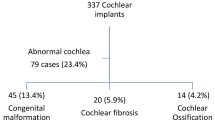Abstract
The aim of present study is to describe the use of the endoscopic assisted cochlear implant approach in cases with severely malformed temporal bones and with anomalous anatomy of the inner ear and tympanic cavity. Eight patients with malformed middle and inner ear and bilateral profound hearing loss were operated using an endoscopic assisted cochlear implant procedure at our tertiary university referral center between January and September 2013. Five patients received a cochlear implant using a suprameatal endoscopic assisted approach. A chart review of clinical data and videos from the operations was performed. All procedures were re-analyzed and codified. In all patients, discharge from hospital was on the third day post-surgery. No immediate or late postoperative complications were noted. The current mean follow-up is 6 months, with range between 4 and 12 months. This approach proved to be successful in cochlear implant placement. It guaranteed a very good control on the facial nerve, even in cases with difficult anatomical conditions, mainly thanks to the endoscopic procedure. It also permitted an appropriate anatomical orientation of the abnormal middle ear with a direct safe cochleostomy, when the round window position would have been difficult to treat using a traditional approach.







Similar content being viewed by others
References
Jackler RK, Luxford WM, House WF (1987) Congenital malformations of the inner ear: a classification based on embryogenesis. Laryngoscope 97:2–14
McClay JE, Tandy R, Grundfast K et al (2002) Major and minor temporal bone abnormalities in children with and without congenital sensorineural hearing loss. Arch Otolaryngol Head Neck Surg 128:664–671
Sennaroglu L, Saatci I (2002) A new classification for cochleovestibular malformations. Laryngoscope 112:2230–2241
Mylanus EAM, Rotteveel LJC, Leeuw RL (2004) Congenital malformation of the inner ear and pediatric cochlear implantation. Otol Neurotol 25:308–317
Hoffman RA, Downey LL, Waltzman SB, Cohen NL (1997) Cochlear implantation in children with cochlear malformations. Am J Otol 18:184–187
Graham JM, Phelps PD, Michaels L (2000) Congenital malformations of the ear and cochlear implantation in children: review and temporal bone report of common cavity. J Laryngol Otol Suppl 25:1–14
Sennaroglu L, Sarac S, Ergin T (2006) Surgical results of cochlear implantation in malformed cochlea. Otol Neurotol 27:615–623
Free R, Falcioni M, Di Trapani G, Giannuzzi A, Russo A, Sanna M (2013) The role of subtotal petrosectomy in cochlear implant surgery—a report of 32 cases and review on indications. Otol Neurotol 34:1033–1040
Kronenberg J, Migirov L, Dagan T (2001) Suprameatal approach: new surgical approach for cochlear implantation. J Laryngol Otol 115:283–285
Kronenberg J, Migirov L, Baumgartner WD (2004) The suprameatal approach in cochlear implant surgery: an alternative surgical approach to cochlear implantation. Otol Neurotol 25:41–44
Postelmans J, Van Spronsen E, Grolman W et al (2011) An evaluation of preservation of residual hearing using the suprameatal approach for cochlear implantation: can this implantation technique be used for preservation of residual hearing? Laryngoscope 121:1794–1799
Marchioni D, Alicandri-Ciufelli M, Piccinini A, Genovese E, Presutti L (2010) Inferior retrotympanum revisited: an endoscopic anatomic study. Laryngoscope 120(9):1880–1886
Marchioni D, Villari D, Mattioli F, Alicandri-Ciufelli M, Piccinini A, Presutti L (2013) Endoscopic management of attic cholesteatoma: a single-institution experience. Otolaryngol Clin North Am 46(2):201–209
Marchioni D, Grammatica A, Alicandri-Ciufelli M, Genovese E, Presutti L (2014) Endoscopic cochlear implant procedure. Eur Arch Otorhinolaryngol 271:959–966
Acknowledgments
These cases were derived from the Otolaryngology Department, University Hospital of Modena.
Conflict of interest
All of the authors have read and approved the manuscript. None of them have any financial relationships to disclose.
Author information
Authors and Affiliations
Corresponding author
Rights and permissions
About this article
Cite this article
Marchioni, D., Soloperto, D., Guarnaccia, M.C. et al. Endoscopic assisted cochlear implants in ear malformations. Eur Arch Otorhinolaryngol 272, 2643–2652 (2015). https://doi.org/10.1007/s00405-014-3214-0
Received:
Accepted:
Published:
Issue Date:
DOI: https://doi.org/10.1007/s00405-014-3214-0




